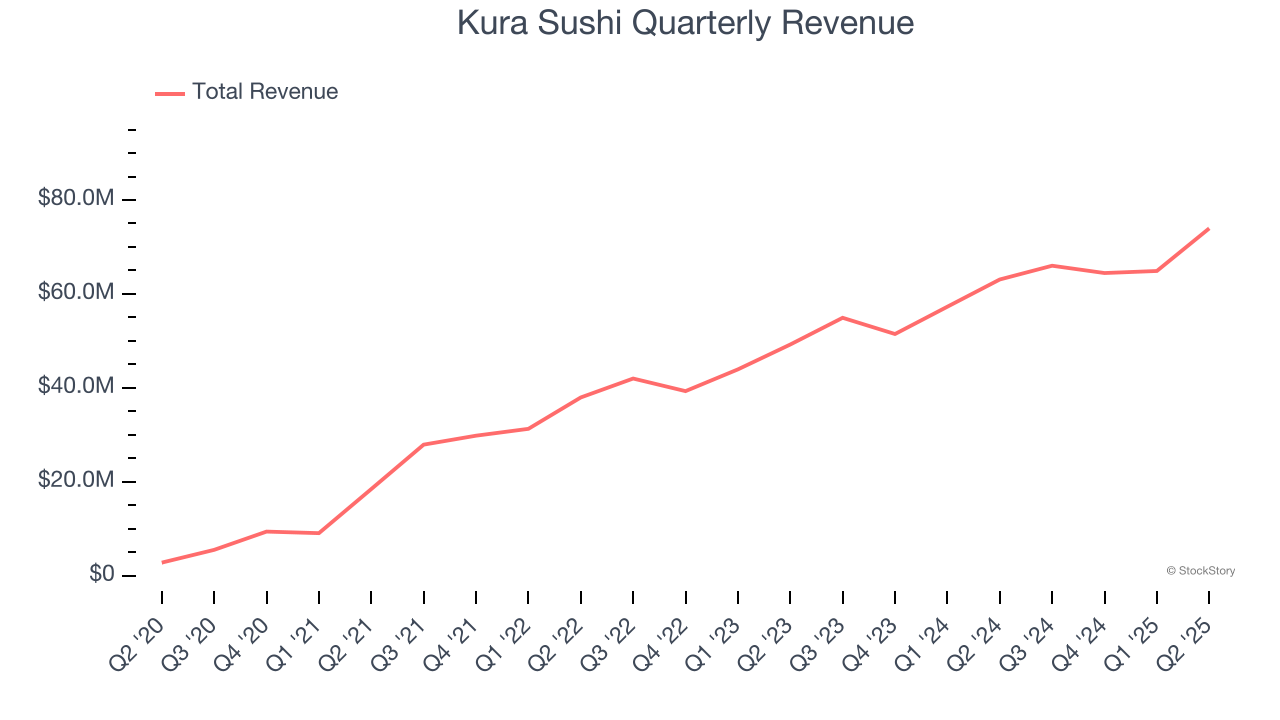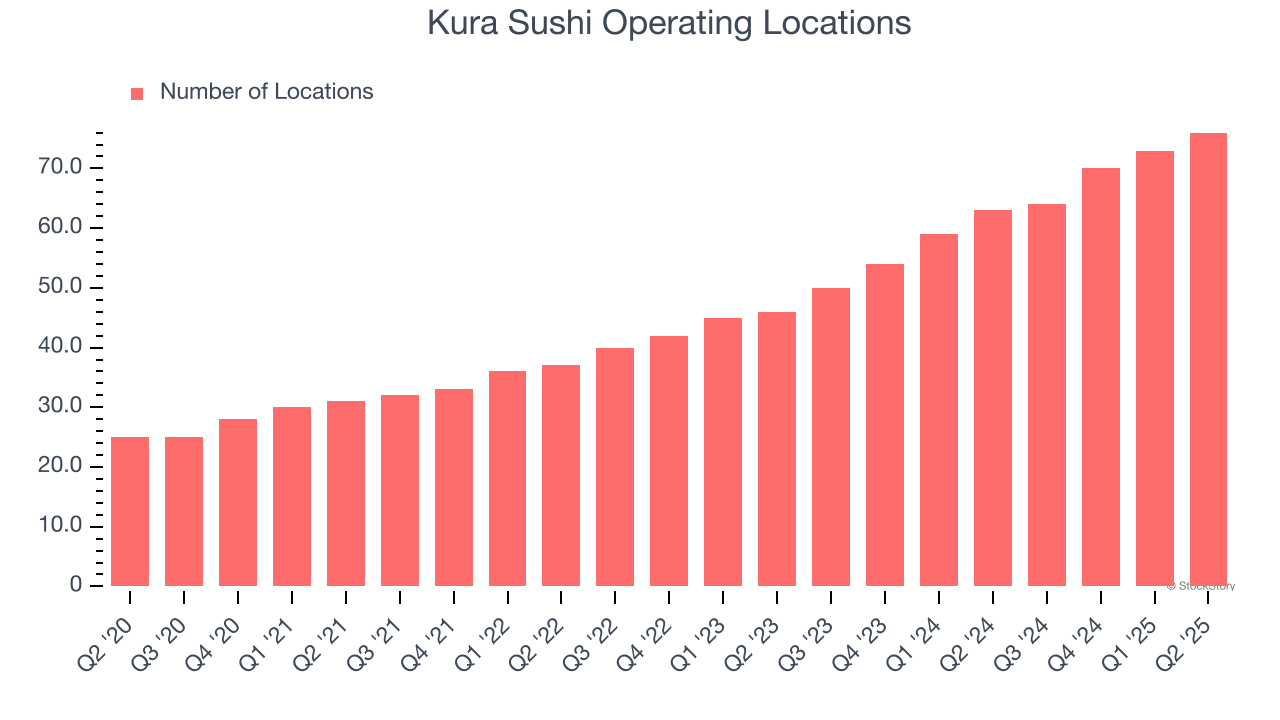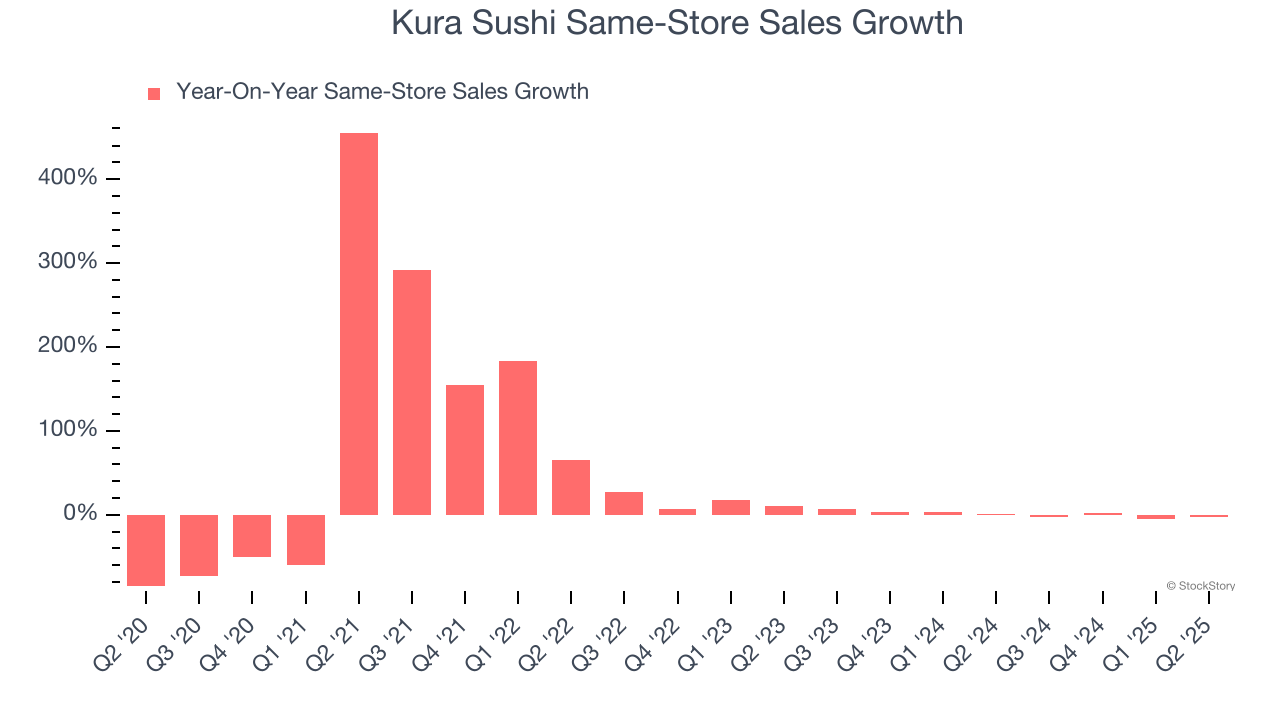
Sushi restaurant chain Kura Sushi (NASDAQ: KRUS) announced better-than-expected revenue in Q2 CY2025, with sales up 17.3% year on year to $73.97 million. The company’s full-year revenue guidance of $281 million at the midpoint came in 0.9% above analysts’ estimates. Its non-GAAP profit of $0.05 per share was significantly above analysts’ consensus estimates.
Is now the time to buy Kura Sushi? Find out by accessing our full research report, it’s free.
Kura Sushi (KRUS) Q2 CY2025 Highlights:
- Revenue: $73.97 million vs analyst estimates of $72.13 million (17.3% year-on-year growth, 2.5% beat)
- Adjusted EPS: $0.05 vs analyst estimates of -$0.01 (significant beat)
- Adjusted EBITDA: $5.41 million vs analyst estimates of $4.84 million (7.3% margin, 11.8% beat)
- The company lifted its revenue guidance for the full year to $281 million at the midpoint from $277 million, a 1.4% increase
- Operating Margin: -0.2%, up from -1.9% in the same quarter last year
- Locations: 76 at quarter end, up from 63 in the same quarter last year
- Same-Store Sales fell 2.1% year on year (0.6% in the same quarter last year)
- Market Capitalization: $1.04 billion
Hajime Uba, President and Chief Executive Officer of Kura Sushi, stated, “The third quarter was a very busy one for us, between rolling out the new reservation system, investigating new market opportunities, and building out our IP pipeline and strategizing on how to get the most out of our Bikkurapon collaborations. I’m extremely pleased with the results on all three fronts, and very proud of the efforts by our team members to capture the full opportunity of the summer season and set ourselves up for a great fiscal 2026.”
Company Overview
Known for its conveyor belt that transports dishes to diners, Kura Sushi (NASDAQ: KRUS) is a chain of sushi restaurants serving traditional Japanese fare with a touch of modernity and technology.
Revenue Growth
A company’s long-term sales performance is one signal of its overall quality. Even a bad business can shine for one or two quarters, but a top-tier one grows for years.
With $269.3 million in revenue over the past 12 months, Kura Sushi is a small restaurant chain, which sometimes brings disadvantages compared to larger competitors benefiting from better brand awareness and economies of scale. On the bright side, it can grow faster because it has more white space to build new restaurants.
As you can see below, Kura Sushi’s 28.4% annualized revenue growth over the last six years (we compare to 2019 to normalize for COVID-19 impacts) was incredible as it opened new restaurants and expanded its reach.

This quarter, Kura Sushi reported year-on-year revenue growth of 17.3%, and its $73.97 million of revenue exceeded Wall Street’s estimates by 2.5%.
Looking ahead, sell-side analysts expect revenue to grow 17% over the next 12 months, a deceleration versus the last six years. Despite the slowdown, this projection is commendable and suggests the market sees success for its menu offerings.
Unless you’ve been living under a rock, it should be obvious by now that generative AI is going to have a huge impact on how large corporations do business. While Nvidia and AMD are trading close to all-time highs, we prefer a lesser-known (but still profitable) stock benefiting from the rise of AI. Click here to access our free report one of our favorites growth stories.
Restaurant Performance
Number of Restaurants
A restaurant chain’s total number of dining locations influences how much it can sell and how quickly revenue can grow.
Kura Sushi sported 76 locations in the latest quarter. Over the last two years, it has opened new restaurants at a rapid clip by averaging 28% annual growth, among the fastest in the restaurant sector. This gives it a chance to scale into a mid-sized business over time.
When a chain opens new restaurants, it usually means it’s investing for growth because there’s healthy demand for its meals and there are markets where its concepts have few or no locations.

Same-Store Sales
The change in a company's restaurant base only tells one side of the story. The other is the performance of its existing locations, which informs management teams whether they should expand or downsize their physical footprints. Same-store sales gives us insight into this topic because it measures organic growth at restaurants open for at least a year.
Kura Sushi’s demand within its existing dining locations has barely increased over the last two years as its same-store sales were flat. Kura Sushi should consider improving its foot traffic and efficiency before expanding its restaurant base.

In the latest quarter, Kura Sushi’s same-store sales fell by 2.1% year on year. This decline was a reversal from its historical levels.
Key Takeaways from Kura Sushi’s Q2 Results
We were impressed by how significantly Kura Sushi blew past analysts’ revenue, EPS, and EBITDA expectations this quarter. We were also excited it raised its full-year revenue guidance. Zooming out, we think this quarter featured some important positives. The stock traded up 6% to $92 immediately after reporting.
Kura Sushi had an encouraging quarter, but one earnings result doesn’t necessarily make the stock a buy. Let’s see if this is a good investment. When making that decision, it’s important to consider its valuation, business qualities, as well as what has happened in the latest quarter. We cover that in our actionable full research report which you can read here, it’s free.




